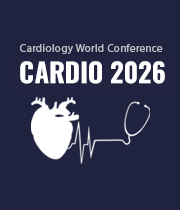Title : Unusual faces of pericardial effusion: A case series of suppurative, neoplastic, and disseminated tuberculous etiologies
Abstract:
Background: Pericardial effusion, though commonly encountered in clinical cardiology, can stem from a multitude of causes—some of which are rare, aggressive, or easily missed. This series showcases three challenging cases from young patients presenting with tamponade physiology due to distinct etiologies: Suppurative infection, Malignancy, and Disseminated tuberculosis.
Case 1 – Post-Cesarean Purulent Pericardial Effusion: A 34-year-old woman, 20 days post-cesarean section, presented in shock with muffled heart sounds and raised JVP. History of dyspnoea since one month, progressive in nature. On arrival patient was tachypnoeic with RR of 50/minute, got electively Intubated in the ER. 2D echo showed massive pericardial effusion with tamponade. Pericardiocentesis revealed yellowish-white pus-like fluid. Analysis showed 22,000 WBCs (99% neutrophils) with MRSA growth on culture. ADA was 110; GeneXpert and ANA were negative. Given the high ADA and clinical picture, anti-tubercular therapy was initiated along with the antibiotics as per culture sensitivity, patient showed dramatic improvement. The patient was discharged on colchicine and steroids and remains stable with a healthy baby on follow-up.
Case 2 – Primary Cardiac Angiosarcoma Missed on Prior Imaging: A 20-year-old woman with a history of pericardiocentesis 23 days earlier presented with dysponea and hypotension. Chest X-ray and 2D echo revealed a mass near the right atrium and large pericardial effusion and impending temponade. CECT, PET-CT and CT guided biopsy confirmed cardiac angiosarcoma--a rare tumor with an incidence of 0.01–0.03%. Notably, her previous CT scan was reported as normal, and pericardial fluid was never sent for cytology. The misdiagnosis as autoimmune effusion led to treatment delays. She is currently stable, receiving chemotherapy and awaiting surgical intervention.
Case 3 – Miliary Tuberculosis Presenting as Tamponade in Young Male: A 35-year-old man on multiple medications for early-onset Parkinsonism presented with chest pain, hypotension, and anxiety. Suspected initially to have pulmonary embolism, 2D echo revealed a large pericardial effusion with tamponade. Pericardial fluid was straw-colored with biochemical features suggestive of tuberculosis (high ADA, LDH). HRCT showed miliary TB with incidentally noted mixed lytic and sclerotic lesions likely vertebral abscess at D10–D12 vertebral bodies, with associated peri-vertebral collection from D12-L2. EF dropped post-pericardiocentesis to 25%; the patient was In shock with oliguria progressing to anuria, required triple inotropes. HIV was negative. First-line anti-TB drugs were stopped due to drug-induced hepatitis and second-line ATT was started. CT coronary angiography ruled out ACS. He improved clinically, supports were tapered and stopped, patient is doing well and is currently on regular follow-ups.
Discussion: These cases emphasize the diagnostic spectrum and clinical variability of pericardial effusions. From MRSA-infected purulent collections and aggressive malignancies like angiosarcoma to systemic tuberculosis presenting with vertebral abscess and cardiac tamponade, a high index of suspicion and thorough systemic work-up is essential. Each case demanded a unique diagnostic approach—highlighting the significance of pericardial fluid analysis, imaging, and clinical correlation. The cases illustrate the spectrum of pericardial effusion—ranging from malignant to infective and autoimmune causes. Cardiac angiosarcoma, though rare, should be considered in young patients with hemorrhagic effusion and atypical imaging findings. Tuberculous and autoimmune etiologies remain prevalent in the Indian population and demand high clinical suspicion. Early therapeutic intervention in infective causes significantly alters outcomes, unlike malignant etiologies which often carry poor prognosis.
Conclusion: Pericardial effusions in young adults warrant meticulous evaluation. Cytology, imaging, ADA, and microbiology can reveal hidden culprits. Early identification and individualized management—especially in high-risk or rare causes—can be life-saving. Rare etiologies of pericardial effusion must be actively sought in young patients with recurrent or atypical presentations. Timely recognition, targeted treatment, and avoidance of mislabeling can significantly alter outcomes, especially in malignant and infective cases.



